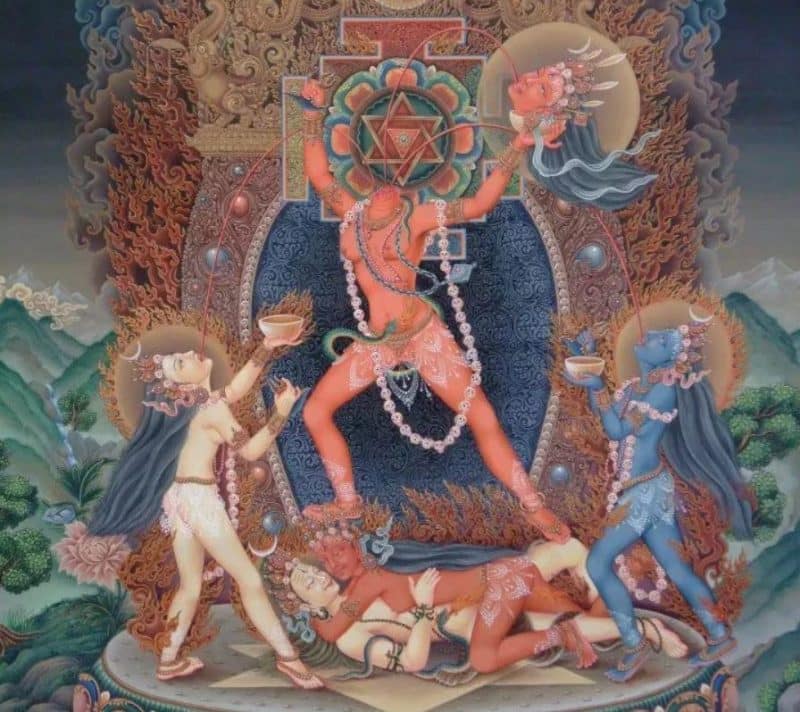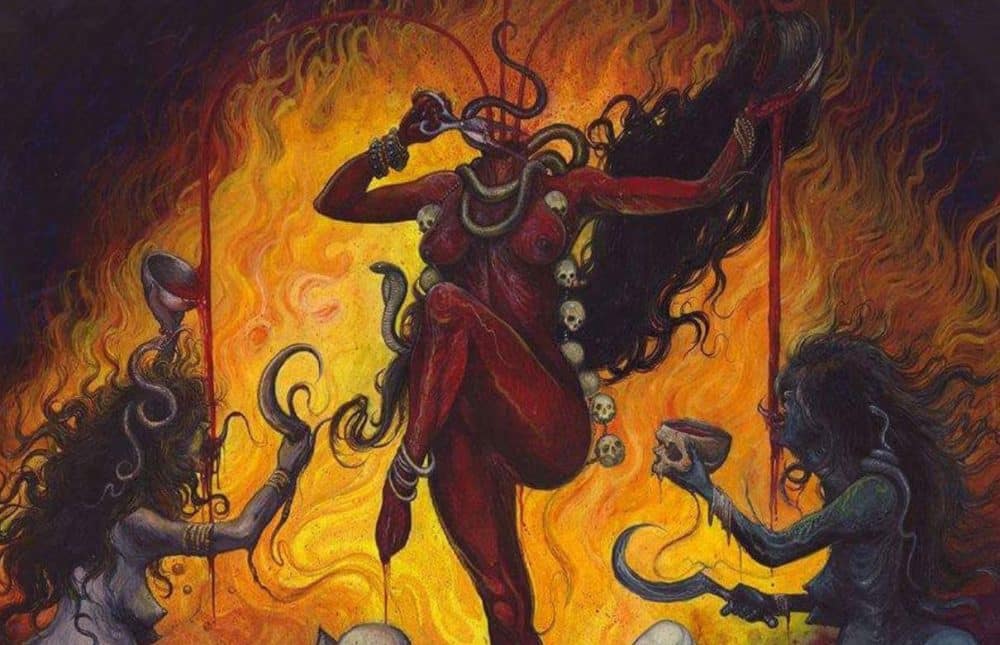Chinnamasta is the Hindu Goddess of transformation. She is the sixth of the Dasa Mahavidya, the wisdom Goddesses, and is also known as Chhinnamastika or Prachanda Chandika.
She is depicted holding her own head, which she has just cut off. She is known as the self-decapitated Goddess and also as Prachanda Chandika. She is a form of Shakti with ferocious power. Chinnamasta actually means, “severed head”, and in Hindu dharma, she is often correlated with fearsome nature.
Buddhists believe she is closely related to Chinnamunda, the severe-headed form of Vajrayogini, the Tibetan Buddhist goddess.
Iconography
In the shrines and depictions, she is mostly nude with disheveled hair with blood covering her body. She stands over a naked couple, who are said to be Kama Deva and Rati. Rati – the Goddess of sexual desire – and her husband the Kama – the God of love.

She wears a serpent with a sacred thread and garland of skulls. Blood spills out of her neck in the depiction, and it is being savored by her female attendants – Dakini and Varini. She holds her own head on the left hand and a Khatri on her right through which she cut her head off. In the ancient textbooks, she is only 16 with full-breast and blue lotus near her heart.
Birth of Chinnamasta
Many stories prevail regarding the birth of Chinnamasta. One of the popular stories has it that when Parvati was taking a bath in the Mandakini river, she was aroused and turned black. Her two attendants Dakini and Varnini got hungry and asked the Goddess to feed their hunger. Since there was nothing to eat, Goddess Parvati severed her head and blood flowed in three directions: two in the attendants’ mouths and one in her mouth. This is where Parvati took the form of Goddess Chhinnamasta.
Symbolism of Chhinnamasta

Chinnamasta is symbolic of life, death, and sex – the three forms of transformation and the three parts of the cycle. Her stance could be the victory over the samsara – the cycle of birth, death, and rebirth. Her depiction of how she stands over the couple signifies a person’s control over sexual desire, while others consider it to be the embodiment of sexual energy.
What’s in her power and what can she control
Doctors, Surgeons, chemists (especially organic chemistry), geologists, fisheries, plastic, fiber technology, tires, rubber, Tar, molasses, alcohol, liquid gas, refined petrol, freezers, refrigerators, cold storages, engines, electrical appliances, tanning technology, speculations, gambling, share brokers
Worship of Chinnamasta
While she is not a popular goddess amongst the Hindus, Tantric practitioners do worship her to acquire siddhis and supernatural powers. But, in many places, people worship her as Goddess Kali.
You can only find her temples in the northern part of India and in Nepal. Chintpurni in Himachal Pradesh, Chhinnamasta Temple in Rajrappa, Durga Temple in Uttar Pradesh, Kamakhya Temple in Jharkhand, Changu Narayan Temple in Kathmandu, Nepal are some of the places where you can find her shrines.
Chinnamasta Mantras
Ekakshar Chhinnamasta Mantra (1 Syllable Mantra)
हूं॥
Hum॥
Tryakshar Chhinnamasta Mantra (3 Syllables Mantra)
ॐ हूं ॐ॥
Om Hum Om॥
Chaturakshar Chhinnamasta Mantra (4 Syllables Mantra)
ॐ हूं स्वाहा॥
Om Hum Svaha॥
Panchakshar Chhinnamasta Mantra (5 Syllables Mantra)
ॐ हूं स्वाहा ॐ॥
Om Hum Svaha Om॥
Shadakshar Chhinnamasta Mantra (6 Syllables Mantra)
ह्रीं क्लीं श्रीं ऐं हूं फट्॥
Hreem Kleem Shreem Aim Hum Phat॥
Chhinnamasta Gayatri Mantra
ॐ वैरोचन्ये विद्महे छिन्नमस्तायै धीमहि तन्नो देवी प्रचोदयात्॥
Om Vairochanye Vidmahe Chhinnamastayai Dhimahi Tanno Devi Prachodayat॥

